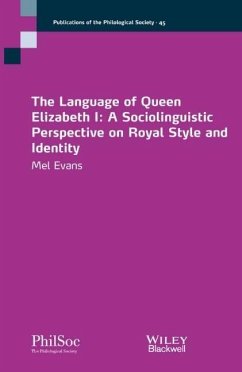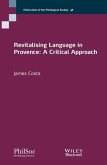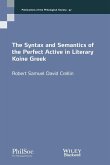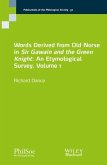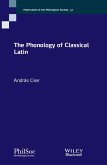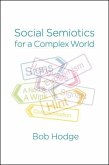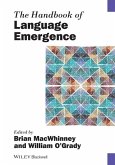- Broschiertes Buch
- Merkliste
- Auf die Merkliste
- Bewerten Bewerten
- Teilen
- Produkt teilen
- Produkterinnerung
- Produkterinnerung
The Language of Queen Elizabeth I presents one of thefirst diachronic accounts of the language - the idiolect - of the Tudor monarch who ruled England andIreland from 1558-1603.
Suggests that Elizabeth I was a leader of language innovationand change, using it to build her complex social identity as afemale monarch in a masculine position of power Examines a number of the monarch's letters, speeches, andtranslations Establishes Elizabeth I's participation in tenmorpho-syntactic changes and explores her spelling practice Develops theoretical and methodological frameworks ofvariationist…mehr
Andere Kunden interessierten sich auch für
![Revitalising Language in Provence Revitalising Language in Provence]() James CostaRevitalising Language in Provence39,99 €
James CostaRevitalising Language in Provence39,99 €![The Syntax and Semantics of the Perfect Active in Literary Koine Greek The Syntax and Semantics of the Perfect Active in Literary Koine Greek]() Robert CrellinThe Syntax and Semantics of the Perfect Active in Literary Koine Greek40,99 €
Robert CrellinThe Syntax and Semantics of the Perfect Active in Literary Koine Greek40,99 €![Words Derived from Old Norse in Sir Gawain and the Green Knight Words Derived from Old Norse in Sir Gawain and the Green Knight]() Richard DanceWords Derived from Old Norse in Sir Gawain and the Green Knight40,99 €
Richard DanceWords Derived from Old Norse in Sir Gawain and the Green Knight40,99 €![The Phonology of Classical Latin The Phonology of Classical Latin]() Andras CserThe Phonology of Classical Latin40,99 €
Andras CserThe Phonology of Classical Latin40,99 €![Building Meaning in Context Building Meaning in Context]() Hannah GibsonBuilding Meaning in Context40,99 €
Hannah GibsonBuilding Meaning in Context40,99 €![Social Semiotics for a Complex World Social Semiotics for a Complex World]() Bob HodgeSocial Semiotics for a Complex World66,99 €
Bob HodgeSocial Semiotics for a Complex World66,99 €![The Handbook of Language Emergence The Handbook of Language Emergence]() The Handbook of Language Emergence205,99 €
The Handbook of Language Emergence205,99 €-
-
-
The Language of Queen Elizabeth I presents one of thefirst diachronic accounts of the language - the idiolect - of the Tudor monarch who ruled England andIreland from 1558-1603.
Suggests that Elizabeth I was a leader of language innovationand change, using it to build her complex social identity as afemale monarch in a masculine position of power
Examines a number of the monarch's letters, speeches, andtranslations
Establishes Elizabeth I's participation in tenmorpho-syntactic changes and explores her spelling practice
Develops theoretical and methodological frameworks ofvariationist sociolinguistics through the analysis of theindividual speaker
Argues for the significance of style as a linguistic andmaterial property in our account of language variation andchange
Hinweis: Dieser Artikel kann nur an eine deutsche Lieferadresse ausgeliefert werden.
Suggests that Elizabeth I was a leader of language innovationand change, using it to build her complex social identity as afemale monarch in a masculine position of power
Examines a number of the monarch's letters, speeches, andtranslations
Establishes Elizabeth I's participation in tenmorpho-syntactic changes and explores her spelling practice
Develops theoretical and methodological frameworks ofvariationist sociolinguistics through the analysis of theindividual speaker
Argues for the significance of style as a linguistic andmaterial property in our account of language variation andchange
Hinweis: Dieser Artikel kann nur an eine deutsche Lieferadresse ausgeliefert werden.
Produktdetails
- Produktdetails
- Publications of the Philological Society
- Verlag: Wiley & Sons
- 1. Auflage
- Seitenzahl: 266
- Erscheinungstermin: 16. September 2013
- Englisch
- Abmessung: 226mm x 147mm x 13mm
- Gewicht: 318g
- ISBN-13: 9781118672877
- ISBN-10: 1118672879
- Artikelnr.: 39318271
- Herstellerkennzeichnung
- Libri GmbH
- Europaallee 1
- 36244 Bad Hersfeld
- gpsr@libri.de
- Publications of the Philological Society
- Verlag: Wiley & Sons
- 1. Auflage
- Seitenzahl: 266
- Erscheinungstermin: 16. September 2013
- Englisch
- Abmessung: 226mm x 147mm x 13mm
- Gewicht: 318g
- ISBN-13: 9781118672877
- ISBN-10: 1118672879
- Artikelnr.: 39318271
- Herstellerkennzeichnung
- Libri GmbH
- Europaallee 1
- 36244 Bad Hersfeld
- gpsr@libri.de
Mel Evans is a Lecturer in English Language at the University of Birmingham. Her research explores the relationship between language variation and change, style, and identity in contemporary and Early Modern English, with a particular interest in the language of the Tudor Court.
Acknowledgements
List of Abbreviations
Part 1
1. Introduction 1
1.1 Historical Sociolinguistics
1.2 Research Question 1
1.3 Research Question 2
1.4 Research Question 3
2. The Elizabeth I Corpus (QEIC)
3. Methodology
3.1 Macro-level Corpora
3.2 Comparative Analysis
3.3 Social Factors
3.4 Interactive Factors
3.5 Stylistic Factors
3.6 Systemic Factors
3.7 Linguistic Factors
Part 2: Results and Analysis
4. Affirmative Do
4.1 Results
4.2 Social Factors
4.3 Systemic Factors
4.4 Interactive Factors
4.5 Stylistic Factors
4.6 Summary
5. Negative Do
5.1 Results
5.2 Systemic Factors
5.3 Social Factors
5.4 Interactive Factors
5.5 Stylistic Factors
5.6 Summary
6. The Replacement of Ye by You
6.1 Results
6.2 Social Factors
6.3 Stylistic Factors
6.4 Interactive and Systemic Factors
6.5 Summary
7. First- and Second-Person Possessive Determiners
7.1 Results
7.2 Social Factors
7.3 Stylistic Factors
7.4 Interactive Factors
7.5 Summary
8. Multiple Negation vs. Single Negation
8.1 Results
8.2 Systemic Factors
8.3 Social Factors
8.4 Stylistic Factors
8.5 Summary
9. Animacy and Relative Marker: who/which
9.1 Results
9.2 Systemic Factors
9.3 Social Factors
9.4 Interactive Factors
9.5 Stylistic Factors
9.6 Objective case: whom/which
9.7 Summary
10. Which and The Which
10.1 Results
10.2 Social Factors
10.3 Systemic Factors
10.4 Stylistic Factors
10.5 Interactive Factors
10.6 Summary
11. Superlative Adjectives
11.1 Results
11.2 Systemic Factors
11.3 Interactive Factors
11.4 Stylistic Factors
11.5 Double Forms
11.6 Results
11.7 Stylistic Factors
11.8 Summary
12. Royal We and Other Pronouns of Self-Reference
12.1 Background
12.2 Results
12.3 Interactive Factors
12.4 Stylistic Factors
12.5 Comparison with Other Royal Idiolects
12.6 Other Pronouns of Self-Reference
12.7 Summary
13. Spelling
13.1 Background
13.2 Methodology
13.3 Results: Spelling Consistency
13.4 Diachronic Consistency
13.5 Graph Combinations
13.6 Final
13.7 and
13.8 Combinations
13.9 , and
13.10 and
13.11 and
13.12 and
13.13 Idiosyncrasies and Spelling Reform
13.14 Summary
Part 3: Research Questions
14. Research Question 1
14.1 The Gender Question
14.2 Summary
15. Research Question 2
15.1 Case Study 1: The Seymour Letters
15.2 Case Study 2: 1576 Parliamentary Speech
15.3 Case Study 3: The CEEC Hoby Letter
15.4 Case Study 4: 1597 Prayer
15.5 Summary
16. Research Question 3
16.1 Idiolects and Idiosyncrasy
16.2 Adolescence and Adulthood
16.3 Linguistic Leadership
16.4 Innovators, Early Adopters and Networks
16.5 Explaining Progressiveness: Communities of Practice
16.6 Hypercorrection and Linguistic Leadership
16.7 Stylistic Variation and Historical Sociolinguistics
17. Final Word
Part 4: Appendix
18. Tabular Data
19. The Queen Elizabeth I Corpus (QEIC)
19.1 Correspondence
19.2 Speeches
19.3 Translations
19.4 Queen Elizabeth I Corpus: Text Information
Textual Sources
References
List of Abbreviations
Part 1
1. Introduction 1
1.1 Historical Sociolinguistics
1.2 Research Question 1
1.3 Research Question 2
1.4 Research Question 3
2. The Elizabeth I Corpus (QEIC)
3. Methodology
3.1 Macro-level Corpora
3.2 Comparative Analysis
3.3 Social Factors
3.4 Interactive Factors
3.5 Stylistic Factors
3.6 Systemic Factors
3.7 Linguistic Factors
Part 2: Results and Analysis
4. Affirmative Do
4.1 Results
4.2 Social Factors
4.3 Systemic Factors
4.4 Interactive Factors
4.5 Stylistic Factors
4.6 Summary
5. Negative Do
5.1 Results
5.2 Systemic Factors
5.3 Social Factors
5.4 Interactive Factors
5.5 Stylistic Factors
5.6 Summary
6. The Replacement of Ye by You
6.1 Results
6.2 Social Factors
6.3 Stylistic Factors
6.4 Interactive and Systemic Factors
6.5 Summary
7. First- and Second-Person Possessive Determiners
7.1 Results
7.2 Social Factors
7.3 Stylistic Factors
7.4 Interactive Factors
7.5 Summary
8. Multiple Negation vs. Single Negation
8.1 Results
8.2 Systemic Factors
8.3 Social Factors
8.4 Stylistic Factors
8.5 Summary
9. Animacy and Relative Marker: who/which
9.1 Results
9.2 Systemic Factors
9.3 Social Factors
9.4 Interactive Factors
9.5 Stylistic Factors
9.6 Objective case: whom/which
9.7 Summary
10. Which and The Which
10.1 Results
10.2 Social Factors
10.3 Systemic Factors
10.4 Stylistic Factors
10.5 Interactive Factors
10.6 Summary
11. Superlative Adjectives
11.1 Results
11.2 Systemic Factors
11.3 Interactive Factors
11.4 Stylistic Factors
11.5 Double Forms
11.6 Results
11.7 Stylistic Factors
11.8 Summary
12. Royal We and Other Pronouns of Self-Reference
12.1 Background
12.2 Results
12.3 Interactive Factors
12.4 Stylistic Factors
12.5 Comparison with Other Royal Idiolects
12.6 Other Pronouns of Self-Reference
12.7 Summary
13. Spelling
13.1 Background
13.2 Methodology
13.3 Results: Spelling Consistency
13.4 Diachronic Consistency
13.5 Graph Combinations
13.6 Final
13.7 and
13.8 Combinations
13.9 , and
13.10 and
13.11 and
13.12 and
13.13 Idiosyncrasies and Spelling Reform
13.14 Summary
Part 3: Research Questions
14. Research Question 1
14.1 The Gender Question
14.2 Summary
15. Research Question 2
15.1 Case Study 1: The Seymour Letters
15.2 Case Study 2: 1576 Parliamentary Speech
15.3 Case Study 3: The CEEC Hoby Letter
15.4 Case Study 4: 1597 Prayer
15.5 Summary
16. Research Question 3
16.1 Idiolects and Idiosyncrasy
16.2 Adolescence and Adulthood
16.3 Linguistic Leadership
16.4 Innovators, Early Adopters and Networks
16.5 Explaining Progressiveness: Communities of Practice
16.6 Hypercorrection and Linguistic Leadership
16.7 Stylistic Variation and Historical Sociolinguistics
17. Final Word
Part 4: Appendix
18. Tabular Data
19. The Queen Elizabeth I Corpus (QEIC)
19.1 Correspondence
19.2 Speeches
19.3 Translations
19.4 Queen Elizabeth I Corpus: Text Information
Textual Sources
References
Acknowledgements
List of Abbreviations
Part 1
1. Introduction 1
1.1 Historical Sociolinguistics
1.2 Research Question 1
1.3 Research Question 2
1.4 Research Question 3
2. The Elizabeth I Corpus (QEIC)
3. Methodology
3.1 Macro-level Corpora
3.2 Comparative Analysis
3.3 Social Factors
3.4 Interactive Factors
3.5 Stylistic Factors
3.6 Systemic Factors
3.7 Linguistic Factors
Part 2: Results and Analysis
4. Affirmative Do
4.1 Results
4.2 Social Factors
4.3 Systemic Factors
4.4 Interactive Factors
4.5 Stylistic Factors
4.6 Summary
5. Negative Do
5.1 Results
5.2 Systemic Factors
5.3 Social Factors
5.4 Interactive Factors
5.5 Stylistic Factors
5.6 Summary
6. The Replacement of Ye by You
6.1 Results
6.2 Social Factors
6.3 Stylistic Factors
6.4 Interactive and Systemic Factors
6.5 Summary
7. First- and Second-Person Possessive Determiners
7.1 Results
7.2 Social Factors
7.3 Stylistic Factors
7.4 Interactive Factors
7.5 Summary
8. Multiple Negation vs. Single Negation
8.1 Results
8.2 Systemic Factors
8.3 Social Factors
8.4 Stylistic Factors
8.5 Summary
9. Animacy and Relative Marker: who/which
9.1 Results
9.2 Systemic Factors
9.3 Social Factors
9.4 Interactive Factors
9.5 Stylistic Factors
9.6 Objective case: whom/which
9.7 Summary
10. Which and The Which
10.1 Results
10.2 Social Factors
10.3 Systemic Factors
10.4 Stylistic Factors
10.5 Interactive Factors
10.6 Summary
11. Superlative Adjectives
11.1 Results
11.2 Systemic Factors
11.3 Interactive Factors
11.4 Stylistic Factors
11.5 Double Forms
11.6 Results
11.7 Stylistic Factors
11.8 Summary
12. Royal We and Other Pronouns of Self-Reference
12.1 Background
12.2 Results
12.3 Interactive Factors
12.4 Stylistic Factors
12.5 Comparison with Other Royal Idiolects
12.6 Other Pronouns of Self-Reference
12.7 Summary
13. Spelling
13.1 Background
13.2 Methodology
13.3 Results: Spelling Consistency
13.4 Diachronic Consistency
13.5 Graph Combinations
13.6 Final
13.7 and
13.8 Combinations
13.9 , and
13.10 and
13.11 and
13.12 and
13.13 Idiosyncrasies and Spelling Reform
13.14 Summary
Part 3: Research Questions
14. Research Question 1
14.1 The Gender Question
14.2 Summary
15. Research Question 2
15.1 Case Study 1: The Seymour Letters
15.2 Case Study 2: 1576 Parliamentary Speech
15.3 Case Study 3: The CEEC Hoby Letter
15.4 Case Study 4: 1597 Prayer
15.5 Summary
16. Research Question 3
16.1 Idiolects and Idiosyncrasy
16.2 Adolescence and Adulthood
16.3 Linguistic Leadership
16.4 Innovators, Early Adopters and Networks
16.5 Explaining Progressiveness: Communities of Practice
16.6 Hypercorrection and Linguistic Leadership
16.7 Stylistic Variation and Historical Sociolinguistics
17. Final Word
Part 4: Appendix
18. Tabular Data
19. The Queen Elizabeth I Corpus (QEIC)
19.1 Correspondence
19.2 Speeches
19.3 Translations
19.4 Queen Elizabeth I Corpus: Text Information
Textual Sources
References
List of Abbreviations
Part 1
1. Introduction 1
1.1 Historical Sociolinguistics
1.2 Research Question 1
1.3 Research Question 2
1.4 Research Question 3
2. The Elizabeth I Corpus (QEIC)
3. Methodology
3.1 Macro-level Corpora
3.2 Comparative Analysis
3.3 Social Factors
3.4 Interactive Factors
3.5 Stylistic Factors
3.6 Systemic Factors
3.7 Linguistic Factors
Part 2: Results and Analysis
4. Affirmative Do
4.1 Results
4.2 Social Factors
4.3 Systemic Factors
4.4 Interactive Factors
4.5 Stylistic Factors
4.6 Summary
5. Negative Do
5.1 Results
5.2 Systemic Factors
5.3 Social Factors
5.4 Interactive Factors
5.5 Stylistic Factors
5.6 Summary
6. The Replacement of Ye by You
6.1 Results
6.2 Social Factors
6.3 Stylistic Factors
6.4 Interactive and Systemic Factors
6.5 Summary
7. First- and Second-Person Possessive Determiners
7.1 Results
7.2 Social Factors
7.3 Stylistic Factors
7.4 Interactive Factors
7.5 Summary
8. Multiple Negation vs. Single Negation
8.1 Results
8.2 Systemic Factors
8.3 Social Factors
8.4 Stylistic Factors
8.5 Summary
9. Animacy and Relative Marker: who/which
9.1 Results
9.2 Systemic Factors
9.3 Social Factors
9.4 Interactive Factors
9.5 Stylistic Factors
9.6 Objective case: whom/which
9.7 Summary
10. Which and The Which
10.1 Results
10.2 Social Factors
10.3 Systemic Factors
10.4 Stylistic Factors
10.5 Interactive Factors
10.6 Summary
11. Superlative Adjectives
11.1 Results
11.2 Systemic Factors
11.3 Interactive Factors
11.4 Stylistic Factors
11.5 Double Forms
11.6 Results
11.7 Stylistic Factors
11.8 Summary
12. Royal We and Other Pronouns of Self-Reference
12.1 Background
12.2 Results
12.3 Interactive Factors
12.4 Stylistic Factors
12.5 Comparison with Other Royal Idiolects
12.6 Other Pronouns of Self-Reference
12.7 Summary
13. Spelling
13.1 Background
13.2 Methodology
13.3 Results: Spelling Consistency
13.4 Diachronic Consistency
13.5 Graph Combinations
13.6 Final
13.7 and
13.8 Combinations
13.9 , and
13.10 and
13.11 and
13.12 and
13.13 Idiosyncrasies and Spelling Reform
13.14 Summary
Part 3: Research Questions
14. Research Question 1
14.1 The Gender Question
14.2 Summary
15. Research Question 2
15.1 Case Study 1: The Seymour Letters
15.2 Case Study 2: 1576 Parliamentary Speech
15.3 Case Study 3: The CEEC Hoby Letter
15.4 Case Study 4: 1597 Prayer
15.5 Summary
16. Research Question 3
16.1 Idiolects and Idiosyncrasy
16.2 Adolescence and Adulthood
16.3 Linguistic Leadership
16.4 Innovators, Early Adopters and Networks
16.5 Explaining Progressiveness: Communities of Practice
16.6 Hypercorrection and Linguistic Leadership
16.7 Stylistic Variation and Historical Sociolinguistics
17. Final Word
Part 4: Appendix
18. Tabular Data
19. The Queen Elizabeth I Corpus (QEIC)
19.1 Correspondence
19.2 Speeches
19.3 Translations
19.4 Queen Elizabeth I Corpus: Text Information
Textual Sources
References

